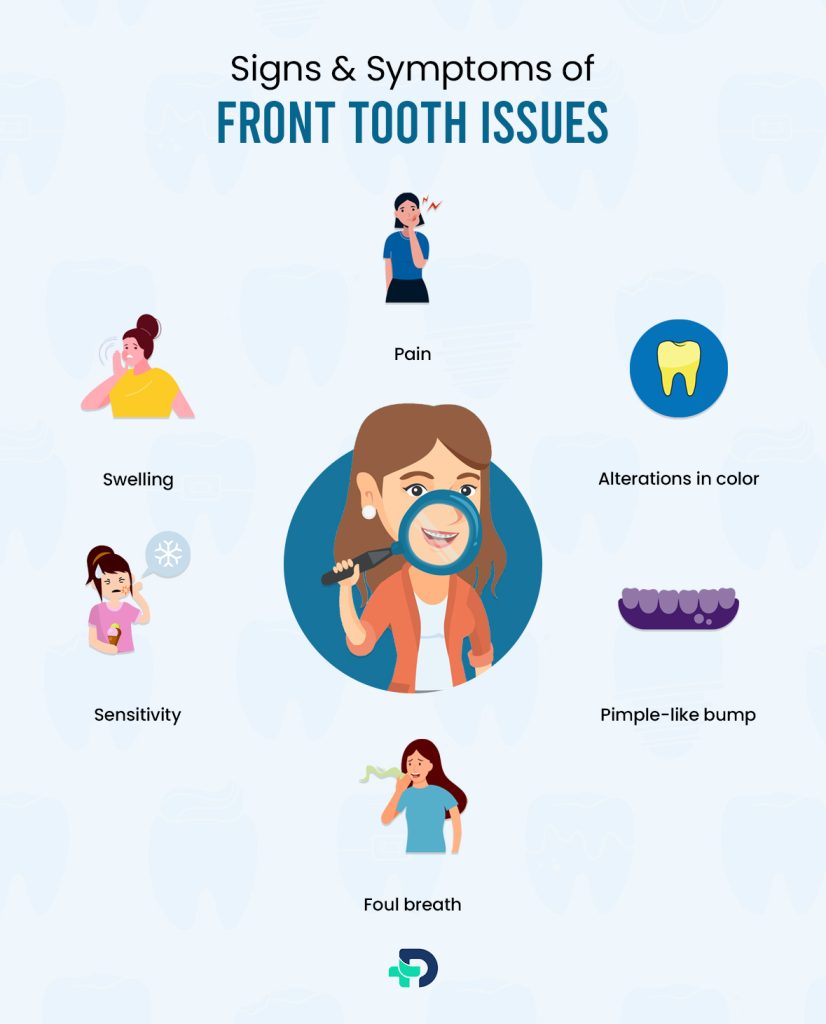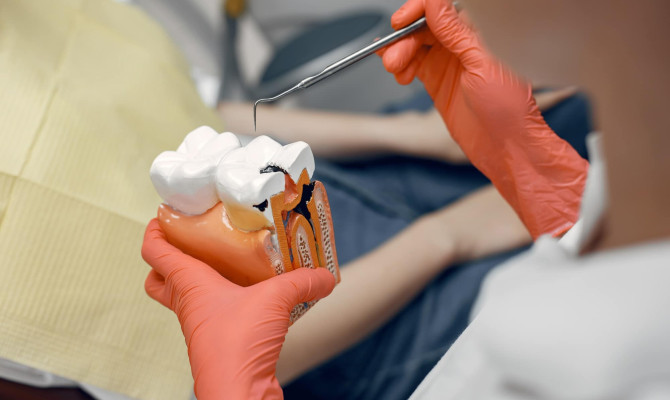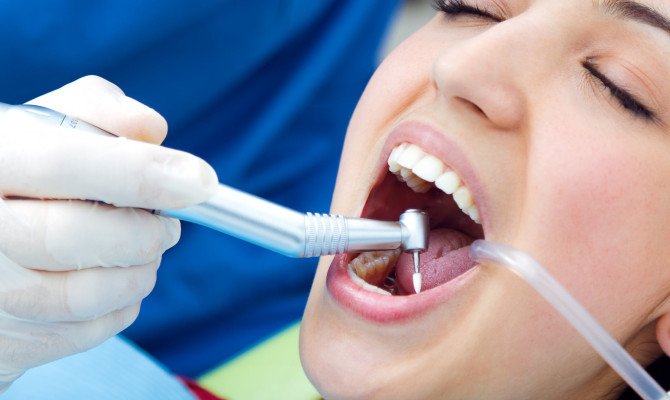Root Canal Front Tooth: What you need to know?

- Root Canal
- 11 Sep 2023
Introduction
Need for Root Canal
An infectious smile is a universal representation of assurance and well-being. In particular, our front teeth significantly influence how we look and interact with others. On the other hand, the pain and aesthetic issues that arise from decay, infection, or damage can be upsetting. This extensive overview will explore the complex world of front tooth root canals. We’ll look at anatomy, necessity, and treatment protocol. In addition, we will talk about possible difficulties, aftercare, and other choices while considering the cosmetic issues in this process. 1 Introduction | Researched based study from American Association of Endodontists

Anatomy
Anatomy of front teeth: A simple explanation
- The teeth you see when you smile are also referred to as incisors.
- These teeth include an easy-to-understand shape that allows you to grin beautifully and easily bite into food.
- The crown and the root are their two fundamental components. The area visible above the gum line is called the crown. Enamel covers it, providing a solid barrier to prevent harm to the tooth.
- The portion known as the root is located below the gum line. The tooth is secured in your jawbone by the root, which functions as an anchor. It is concealed beneath your gums and maintains the two firmly in position.
- The pulp chamber, located inside the crown and root, is a crucial area that contains vital components like blood arteries and nerves. The nerves make you sense temperature changes, and these blood vessels carry nutrients. 1 Anatomy | Researched based study from American Association of Endodontists
Importance
Recognizing the use of root canal therapy
- This procedure is similar to internal dental repair. When a tooth is deeply broken or diseased, a dentist cleans the inside pathogen to eradicate the infection. After that, they shield the tooth to prevent further pain and allow it to remain in your mouth.
- It is a means of saving a tooth in trouble and restoring its health. 1 Importance | Researched based study from American Association of Endodontists
Symptoms

Signs & Symptoms of Front Tooth issues
- Pain
- Swelling
- Color changes
- Sensitivity
- Loose tooth
- Bad breath
The tissues of the front teeth can appear in many ways. If you encounter any of the following symptoms, it can be a sign that something is wrong:
Pain
- Your front teeth may hurt when you bite, consume something hot or cold, or in cases of injury could indicate that there is an issue.
Swelling
- There may be a problem if the gums around your front teeth appear swollen or puffed.
Alterations in color
- It indicates trouble if they appear darker, more yellow, or compared to the rest of your teeth.
Sensitivity
- If they suddenly exhibit extreme sensitivity to heat or cold, there may be a problem.
Pimple-like bump
- An infection may be indicated if you see a tiny pimple-like bump on your gums close to your teeth.
Looseness
- There’s a problem if it seems loose or wiggly even when you’re not trying to move it.
Foul breath
- If you regularly clean and floss your teeth but your foul breath persists, there may be a problem with your front teeth. 1 Symptoms | Researched based study from American Association of Endodontists
Diagnosis
Diagnosing & Getting ready for Medical care
A dentist will go through a procedure to confirm if a root canal is necessary for your teeth if they have any suspicions. This is how they operate:
Listening to you
- Any symptoms you may have, such as discomfort, sensitivity, or swelling around your teeth, may be questioned.
Examining
- The dentist will thoroughly examine your front teeth and look for signs of damage or infection.
- They use a tiny mirror and intense lighting to view every aspect of the teeth.
X-rays
- X-rays provide an accurate picture of the interior workings of the teeth and roots. Dentists can notice things in these images that are not visible to the naked eye.
Sensitivity testing
- Occasionally, they will give the teeth a light touch or apply a cooling sensation.
- They can infer information about the state of your teeth from you if you experience pain or discount it.
Gum health examination
- They will examine the gums surrounding your front teeth to find any signs of inflammation or redness that could point to a problem.
Discussing findings
- Once this information has been gathered, the dentist will explain their findings to you.
- They will discuss the next steps with you and let you know if they believe a root canal is necessary. 2 Diagnosis | Researched based study from National Library of Medicine
Procedure
The Root Canal procedure on Front Tooth
Isolation and anesthesia
- Your dentist numbs the area around your teeth with a local anesthetic to make sure you don’t feel uncomfortable during the procedure.
- To keep it dry and clean, your tooth may be covered with a little piece of rubber (also known as a rubber dam).
Access opening
- A tiny hole is created in the dental crown. This enables them to get to the pulp, or inside portion, that requires treatment.
- Cleaning and shaping, the dentist delicately removes the damaged or infected pulp using specialized instruments.
- They remove any dirt or bacteria by cleaning and shaping the canals.
Cleaning and irrigation
- A unique solution is utilized to ensure that all bacteria have been removed from the interior of the canals.
Filling and sealing
- The dentist uses a biocompatible substance to feel the inside of the canals once the tooth is clean and dry.
- They temporarily or permanently seal the entry opening to safeguard the inside of canals.
- Each step is crucial to ensure that the infection is cleared and your tooth may remain healthy.
- Depending on how the dentist treats you and your condition, the treatment could take one or more visits to finish.
- Remember that the dentist will walk you through the procedure and ensure you feel comfortable. 3 Procedure | Researched based study from Journal of American Dental Association
Recovery
Root Canal Front Tooth – Recovery
Following the recommended aftercare recommendations is crucial to a successful recovery and long-term treatment outcome following root canal therapy for your front teeth.
Discomfort and sensitivity
- It is normal to experience some sensitivity or discomfort in the area surrounding the tooth for a few days after treatment.
- Painkillers available over the counter can help with this. Speak with your dentist if the discomfort is intense or persistent.
Chewing and eating
- It may be suggested that you wait till the treated tooth has wholly healed before chewing on it. Avoid biting into crisp or hard foods.
Oral hygiene
- For the first few days after treatment, stick to your usual dental hygiene schedule but be extra careful around the treated tooth.
- Avoid aggressive brushing and use a toothbrush with gentle bristles.
Preventing high temperatures
- Avoid eating or drinking anything too hot or cold during the first several days.
- Since the teeth may be sensitive, discomfort can be avoided by avoiding extremes.
Medication
- Take antibiotics as directed for the entire specified duration if one is prescribed. To cure or prevent any remaining infection, do this.
Follow-up appointments
- Keep any follow-up appointments that your dentist has scheduled.
- They may monitor your healing process and ensure everything is mending properly throughout these appointments.
Temporary or permanent restorations
- It is crucial to have your tooth restored with a crown or permanent one if it has been given a temporary filling. In doing so, the tooth is strengthened and shielded.
Let your dentist know
- Make immediate contact with your dentist if you encounter any odd symptoms, such as fever, edema, or extreme discomfort.
- This could indicate a more serious issue.
Continue to get periodic dental checkups
- It is essential to have routine dental checkups after the procedure to guarantee that the tooth stays healthy and that any possible problems are found early.
Good dental habits
- Practice proper oral hygiene, like brushing, flossing, and rinsing with an antimicrobial mouthwash, to preserve the health of your treated teeth.
Timing can change depending on specific situations. It is possible to anticipate a good recovery and ongoing dental health if you adhere to your dentist’s advice and take good care of your teeth. 2 Recovery | Researched based study from National Library of Medicine ,3 Recovery | Researched based study from Journal of American Dental Association
Complications
Complications & Risks
Although the surgery is usually safe and effective, you should be informed of potential risks and complications. These are uncommon and may change depending on particular situations.
Infections
- If not, all bacteria are eliminated throughout the treatment, the treated tooth may occasionally become re-infected. It may be necessary to take additional action.
Pain
- Following an operation, minor discomfort is usual, but severe or chronic pain may indicate a problem.
- Inflammation, an ongoing infection, or other issues could bring this on.
Swelling and inflammation
- While some swelling near the treated area is typical, excessive swelling could indicate an infection or treatment reaction.
Incomplete treatment
- Rarely, a dentist may overlook a canal or need to thoroughly clean and seal it, which could result in ongoing problems.
Fractured tooth
- Over time, it may become increasingly fragile. It may occasionally break or fracture and must be removed or treated further.
Allergy reactions
- Certain individuals may have an allergic reaction to specific components during the operation.
Adjacent tissue damage
- During the process, there is a slight chance that nearby blood vessels, nerves, or gums will sustain harm.
Discoloration following therapy
- Over time, the treated tooth may darken due to internal structural alterations or leftover filling materials.
- This may have an impact on how your smile looks.
Need for an additional procedure
- In certain instances, the tooth treated may heal as a necessary side effect of procedures like retreatment or even extraction. 2 Complications | Researched based study from National Library of Medicine ,3 Complications | Researched based study from Journal of American Dental Association
Considerations
Considerations for Front Teeth’s Aesthetics following a Root Canal
When undergoing root canal therapy for front teeth, aesthetic considerations are taken into account, in addition to pain relief and tooth preservation.
Discoloration of teeth
- Following the operation, you and your dentist will talk about your options for treating this, like employing tooth-colored restorations or teeth whitening.
Material for crowns or fillings
- Depending on the amount of the therapy, your dentist may apply a crown or a filling material to the affected tooth. To guarantee a smooth integration, they will select materials similar in tone and appearance to your teeth.
Alignment
- If the alignment was already off before the procedure, orthodontic treatment—such as braces or aligners—might be recommended to improve it.
Smile aesthetic
- They considered tooth size, shape, and overall smile aesthetics when doing root canals. Your tooth will be restored in a style that complements your smile.
Crown design
- When a crown is required following a root canal, your dentist will meticulously craft the crown to match the color and shape of the neighboring teeth, ensuring a harmonious and natural-looking result.
Porcelain veneers
- These tiny shells are specifically designed to cover the teeth’s front surfaces. 2 Considerations | Researched based study from National Library of Medicine
Maintenance
Long-term Dental Health and Maintenance
- After a root canal, maintaining the health of your teeth and ensuring the procedure is successful depends on how well you take care of them.
- Use a soft-bristled toothbrush and fluoride toothpaste to brush your teeth twice daily.
- To remove food particles and plaque between your teeth and around your gums, floss your teeth daily.
- As directed by a dentist, use fluoride mouthwash or an antiseptic.
- Eat a diet rich in fruits, vegetables, whole grains, and protein.
- To avoid tooth decay, consume fewer acidic and sugary foods and beverages.
- Water helps wipe away food particles and keeps your mouth moist.
- Avoid biting into ice; don’t use your teeth to pry open goods.
- If you play sports or grind your teeth at night, use a mouth guard to protect your teeth from injury or issues caused by grinding.
- Get regular cleanings and exams from your dentist.
- If the tooth you are getting treatment for has a crown, maintain it clean and report any discomfort or sensitivity. 4 Maintenance | Researched based study from American Dental Association
Alternatives
Alternative to a Root canal
Extraction
- Your dentist may advise tooth extraction if the substantial damage or infection in your front tooth is untreatable.
- After extraction, dental implants, bridges, or removable dentures might replace the missing one.
Pulpotomy
- If the infection has not progressed far, a pulpotomy may be necessary.
- To preserve the pulp in the root, just the affected portion must be removed for the crown.
Direct pulp capping
- This procedure could be advised if the damage is not severe and the pulp is not severely infected.
- A protective material covering is applied over the exposed pulp to promote healing.
Extraction and immediate implants
- If an emergency dental implant needs to be inserted in addition to the extraction of the front tooth, that appointment may be used.
Bridge
- This involves filling the space left by the removed tooth with a prosthetic.
Removable dentures
- If some of the front teeth are damaged, replacing them with removable dentures may be an option. They can be removed for upkeep and cleaning.
Watch in full, waiting.
- If the infection is not severe or the damage is not significant, your dentist may advise you to monitor the tooth.
- Over time, they will keep a close eye on the state of the teeth. 5 Alternatives | Researched based study from National Library of Medicine
FAQs
FAQs about Root Canal
Is root canal safe for front teeth?
- Yes, well-established, generally safe methods are regularly carried out to prevent further harm to your affected teeth.
How long do front teeth last after a root canal?
- The lifetime of front teeth following a root canal can vary depending on several factors, such as the tooth’s pre-treatment state, the procedure’s quality, dental hygiene habits, and general oral health.
- That generally lasts a very long time following a successful course of treatment.
Do front teeth need a crown after a root canal?
- They are frequently necessary to guarantee durability, functionality, and aesthetic appeal.
- By adding solidity and support, the crown’s placement aids in the lost structural restoration.
- Additionally, it strengthens your teeth again so you can utilize them worry-free for eating.
Why do root canals take two visits?
- For various reasons, a root canal often requires one or more visits, though, in certain circumstances, just one stop may be enough.
- In the initial appointment, the dentist evaluates the state of the tooth, ascertains the degree of infection, and performs cleaning and shaping.
- Complex root canals, with curved or numerous channels, are sometimes possible. It could take them longer than expected to complete all appointments.
The Bottom Line
Root Canal – A Saviour
It is an essential dental operation for front teeth that preserves oral health and cosmetics by repairing and saving broken or infected teeth. Although they are frequently linked to pain alleviation, they also prioritize preserving the aesthetic appeal of the front teeth. Root canals are now securely and effectively performed by dentists thanks to advances in technology in dentistry. Good oral hygiene, regular dental examinations, and proper aftercare contribute to dental treatments’ longevity and success.
Any feedback on this article?
 This Articles content was accurate
This Articles content was accurate Very Informative Article
Very Informative Article I have a question or a comment
I have a question or a comment
 This article contains inaccurate content
This article contains inaccurate content This article was not helpful
This article was not helpful I have a question or a comment
I have a question or a comment
We appreciate your helpful feedback!
Checkout our social pages
References
-
American Association of Endodontists
Introduction | Anatomy | Importance | Symptoms
-
National Library of Medicine
Diagnosis | Recovery | Complications | Considerations
-
The Journal of American Dental Association
Procedure | Recovery | Complications
-
American Dental Association
Maintenance
-
National Library of Medicine
Alternatives






































